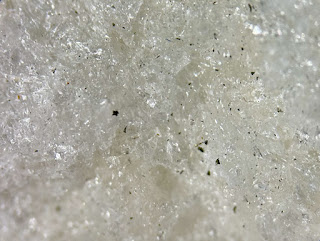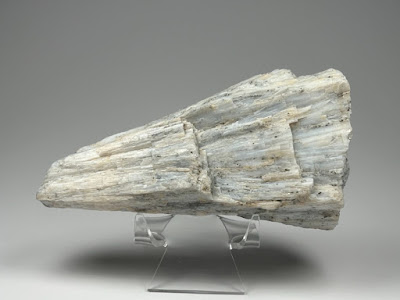石膏のいろいろなかたち Various Forms of Gypsum
1. 繊維石膏 Fibrous Gypsum
Size: 105 × 83 × 63 mm / Weight: 657 g
透石膏(二水石膏の透明結晶)の標本はこのブログですでにいくつか紹介したところだが(たとえばこれやこれ)、この標本は繊維石膏(fibrous gypsum または satin spar)の名で呼ばれていて、多数の石膏の結晶が、ある一方向に向かって一斉に成長して平行連晶したものとされる。こういう結晶成長のしかたは自然界では割とよくあるらしく、身近なところだと霜柱がそうだし、かつて耐火・断熱材としてつかわれた石綿は、ある種の蛇紋石や角閃石が繊維状に成長したものである。秋田県北東部の黒鉱鉱床に付随する石膏帯の産物。
Clear crystalline gypsum (selenite) specimens have been shown in this blog before. This piece of gypsum, called satin spar, shows a distinct texture caused by parallel growth of a number of crystals in one direction. The fibrous crystal habit often occurs in nature, which can be seen, for example, in frost columns and asbestos. It is from a gypsum deposit beside a kuroko (black massive ores containing copper, lead, zinc, etc.) deposit in the Northeast Akita.
2. 雪花石膏 Alabaster
Size: 85 × 70 × 57 mm / Weight: 348 g
おなじ二水石膏の標本だが、これは細かい結晶どうしが固着、集合したもので、雪花石膏(alabaster)の名で呼ばれる。想像ではあるが、水溶液中で微小な結晶が多数析出して、沈殿、圧密したものだろう。この標本の場合、黄鉄鉱も同時に生成しているが、こうした産状は黒鉱型の塊状石膏鉱床でよくみられる。入手時のラベルによると産地は秋田県の長部(おさべ)鉱山で、これは大館市南部を流れる犀川支流の長部沢上流部にあった、鉱脈型の鉱床を掘ったごく小規模の銅山のようだ(たとえば「秋田県鉱山誌」秋田県鉱山会館、2005年)。大館市、鹿角市、小坂町のあたりは地質学的には北鹿ベイスン(盆地)と呼ばれ、黒鉱型と鉱脈型の2つのタイプの銅・鉛・亜鉛鉱床が多数混在している。長部鉱山はその北鹿ベイスンの南端に位置し、もしかしたら主脈の近傍に小規模な黒鉱型石膏鉱床を伴っていたのかもしれない。ちょっと詳細は不明である。
This is another type of gypsum, alabaster, probably created in such a way that many small crystals simultaneously precipitate and compact under a high pressure. Pyrite cooccurred in this example, which is common in a kuroko-type gypsum deposit. However, the Osabe Mine, as written in the label, was a copper mine having small-scale copper-containing hydrothermal veins. It is curious that alabaster was found in a vein-type deposit. There might exist a small-scale kuroko-type massive deposit near Osabe, as it is common that kuroko and vein-type mines coexist in a relatively small area of the Northeast Akita (the Hokuroku Basin).
3. 繊維状硬石膏 Fibrous Anhydrite
Size: 140 × 80 × 45 mm / Weight: 605 g
これは硬石膏(無水石膏)だが、以前紹介した標本とは異なり、結晶が一方向に、繊維状に成長している。色はうっすら青みがかった灰白色で、黄鉄鉱の結晶を多数含んでいる。産地である堤沢は昭和中期に露天掘りしたところで、冒頭の繊維石膏の産地である松峰鉱山に隣接する。
This is anhydrite (dehydrated gypsum) with a fibrous crystal habit, coming from a kuroko-type gypsum deposit near the first specimen's site. It shows a slightly bluish gray color and includes small pyrite crystals.
長崎則夫ほか「釈迦内鉱山における石膏の産状」(鉱山地質 33巻 1号、1983年)によれば、釈迦内地区(松峰や花岡に隣接する鉱区)の石膏帯の浅部には二水石膏(おもに雪花石膏)、深部には無水石膏が分布する。一般に硫酸カルシウムと水とが共存するとき、温度が高ければ無水石膏が、低ければ二水石膏が安定的に存在できる。その境界の温度は、圧力等の諸条件にもよるが、おおむね摂氏100度前後とされる。長崎らは、鉱床が生成して地盤が沈降し、高い地温にさらされていた時期はすべて硬石膏だったが、その後隆起して温度が低下し、石膏帯の上部のみ天水によって水和されたのだろうと推論している。
黒鉱型石膏鉱床では繊維石膏や透石膏は比較的まれである。おなじく長崎らの論文によれば、釈迦内地区の繊維石膏は鉱体中またはその周囲に伸びる細脈に産出する。脈幅は 5 cm 以下で、両盤際から脈中央に向かって櫛状に結晶が生成する。まさに霜柱みたいな産状で、形成機構にも共通点があるのではないかとおもわれる。透石膏は鉱体中のガマ(空洞部分)に生成するが、鉱体の中心よりはむしろ末端部に多くみられるという。
A study indicates that the upper part of a kuroko-type gypsum deposit in Odate area mainly consists of alabaster, and the lower part is generally anhydrite. As anhydrite is more stable in a higher temperature condition (about 100℃ or higher, depending on various conditions), it is reasonable that the upper part hydrated when the deposit rose and low-temperature water became plenty. Fibrous gypsum, which is relatively rare, occurrs as a thin vein of less than 5-cm thickness. It looks like the crystals grow from the both wall surfaces to the vein's center. Selenite is also rare in a kuroko-type deposit. It is found in a vug, more frequently in the outer rim rather than in the central part of the deposit.







